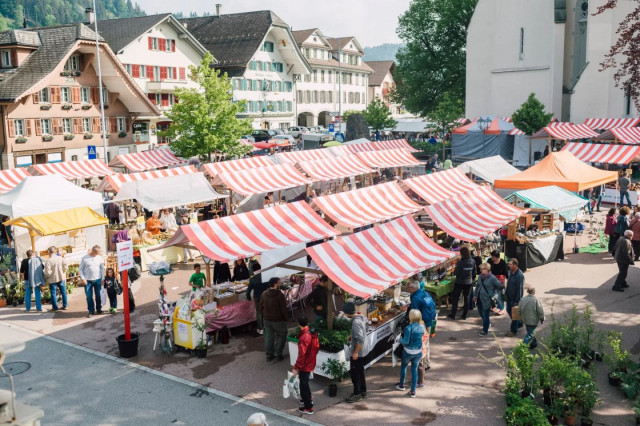Nature conservation and regional economic development
Written by Lukas König and Janis Büchel, students at the University of Zurich
Parks are a good way of linking and promoting nature conservation and regional economic development. Switzerland has a nationwide system of nature parks with three denominations: 1. National Park 2. Regional nature parks 3. Nature discovery park. In this blog post we want to zoom into the 17 Swiss regional nature parks. These parks are designated areas of high natural and cultural importance in rural areas. The goal of these parks is to protect nature while also finding sustainable solutions for economic development in these areas. There is a national legal framing as well as adherence to UNESCO rule work (BAFU: 2024). This blog post discusses the two major pillars which constitutes the regional parks system: 1. nature preservation and 2. Economic development.
There are multiple requirements for a regional nature park in Switzerland, it should preserve and enhance the quality of nature and landscape (BAFU, 2007). This means that, on one hand, the landscape of the park must be distinctive and perceived as "beautiful", on the other hand, the habitats of the native animal and plant species must not be disturbed (Hammer et al., 2022). Habitats should be well connected and the landscape should be protected accordingly or even improved when building new infrastructure (BAFU, 2007). An example to increase the ecological diversity of regional nature parks is the renaturation of fens and raised bogs or other ecologically valuable areas. However, it is difficult to quantify the impact of a regional nature park on biodiversity (Hammer et al., 2022); it is easier to do so for economic aspects.
The establishment – and arguably the success – of regional parks depends on the support of the local population, because the federal government only supports such projects (Ritzel et al. 2023). As support is often determined by municipal vote of the participating municipalities, the inhabitants must – aside from ecologic moral – be convinced by tangible economic impact. By laying an emphasis on sustainable economic development of the involved municipalities the park management can work with long-running support and funding to protect the environment long-term. The parks can for example impact the local economies with branding. The park brand can induce tourist inflows, help marketing products from such region and build a strong identification of the inhabitants with their region and regional economy. Assessing the economic impact of such parks, literature paints a more mixed picture: Farmers inside a park didn't receive negative economic performance but at the same time no higher performance either (Ritzel et al. 2023). Furthermore, the induced incoming tourists are mainly one-day visitors, which don't contribute much money to the region per head compared to overnight guests (Knaus 2018). Siegrist et al (2007) found, although the economic potential of the parks is rather low, they can have catalyst function, depending on the prerequisites. Therefore, we can conclude: the regional nature parks are an interesting tool of nature and landscape protection, while their effectiveness is still subject of scientific debate.
Bibliography
BAFU (2024) Pärke von nationaler Bedeutung. Available at: https://www.bafu.admin.ch/bafu/de/home/themen/landschaft/fachinformationen/landschaften-nationaler-bedeutung/paerke-von-nationaler-bedeutung.html (Accessed: 29.11.2024).
BAFU (2007) AS 2007 5241 - Verordnung über die Pärke von nationaler Bedeutung, Fedlex. Available at: https://www.fedlex.admin.ch/eli/oc/2007/743/de (Accessed: 1.12.2024).
Hammer, T. et al. (2022) A holistic assessment of the impacts of park management: findings from the evaluation of Regional Nature Parks in Switzerland, Journal on Protected Mountain Areas Research and Management, 14/1, pp. 14–24. Accessed: https://doi.org/10.1553/eco.mont-14-1s14.
Knaus F. (2018) Charakteristiken von Gästen in vier Schweizer Naturpärken und deren touristisch induzierte Wertschöpfung. Untersuchungen anhand des Parc Jura vaudois, Parc Ela, Naturpark Gantrisch und Landschaftspark Binntal. Projektbericht des Netzwerks Schweizer Pärke, Bern and ETH Zurich Zurich.
Ritzel C., Hoop D., Portmann M., Wallner A., Mack G. (2023) Swiss Parks of National Importance as model regions of sustainable development – An economic success story for farmers? Land use policy.
Siegrist D., Aufdereggen M., Lintzmeyer F., Spiess H. (2007) The Economic Potential of Regional Nature Parks in Switzerland: A Case Study of the Planned Regional Nature Parks in the Canton of Bern. In: Mose, I. (eds.). (2007) Protected Areas and Regional Development in Europe. Towards a New Model for the 21st Century. 1. Ed. Routledge, London.
Comments
By accepting you will be accessing a service provided by a third-party external to https://www.mountainapp.net/
This website uses no external trackers, no analytics, just session cookies and values your online privacy.



